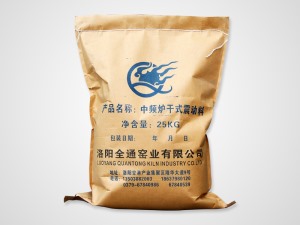What are the methods of lining the intermediate frequency furnace charge?
Intermediate frequency furnace lining material is also called intermediate frequency furnace lining material, intermediate frequency furnace dry vibrating material, intermediate frequency furnace dry pounding material, intermediate frequency furnace ramming material, etc. It is divided into acidic, neutral and basic furnace lining materials. Acid furnace lining materials are made of high-purity quartz, Fused silica is the main raw material, and composite additives are used as sintering agents; the neutral furnace lining is made of alumina and high-alumina materials as the main raw materials, and the composite additives are used as sintering agents; the basic furnace lining is high-purity fused corundum, high-purity Fused magnesia and high-purity spinel are used as the main raw materials, and composite additives are used as sintering agents.
Alkaline furnace lining: mainly used for melting all kinds of high alloy steel, carbon steel, high manganese steel, high chromium steel, tool steel, stainless steel and other alloy steel.
Acid lining: Mainly used for the working lining of coreless induction furnaces for melting and holding cast iron.
Acid, neutral and basic furnace linings are widely used in coreless intermediate frequency furnaces and cored induction furnaces as intermediate frequency furnace lining materials for melting gray cast iron, ductile iron and cast iron alloys, melting carbon steel, alloy steel, high manganese Steel, tool steel, heat-resistant steel, stainless steel, molten aluminum and its alloys, molten copper, brass, cupronickel and bronze and other copper alloys.
There are two kinds of knotting methods for intermediate frequency thermal induction furnace lining, wet knotting and dry knotting. Both methods can be used for knotting of acid intermediate frequency furnace lining, neutral furnace lining and basic furnace lining.
The intermediate frequency furnace wet knotting refers to the knotting by adding water, water glass, brine and other adhesives to the lining knotting material. Because the knotting material contains a certain amount of moisture, there is less dust during construction and good formability. However, there are also a series of defects in wet knotting: the lining material knotted in the intermediate frequency furnace is not dense enough, and the refractoriness of the lining decreases; the drying time of the lining is long; the moisture in the lining causes the sensor to gasify. The insulation function of the furnace is reduced. If the treatment is not good, it often leads to the breakdown of the inter-turn fire, and may also cause a short circuit to the ground. Therefore, for the larger smelting intermediate frequency furnace, the wet lining should be prevented as much as possible.
The dry furnace building method is now widely used in the furnace building of the crucible induction furnace. The dry intermediate frequency furnace building method without cement can exert the refractory function of the lining material to a great extent, and make the sintered layer of the furnace lining. Thinning, thickening the powder layer, reducing the heat dissipation loss of the furnace lining, reducing the tendency of furnace lining cracks, and improving the safety and reliability of the furnace lining.

Related Industry Knowledge
- Features and Benefits of Coil Clay
- What are the advantages of a good furnace lining
- Misunderstandings in the use of ramming materials in intermediate frequency furnaces
- Phenomenon analysis of failure of argon blowing of ladle permeable bricks and how to improve the rate of argon blowing
- Where is the consumption reduction and energy saving of breathable bricks reflected?
- How to improve the service life of intermediate frequency furnace lining
- Reasons for damage to intermediate frequency furnace lining and how to solve them
- The performance and advantages of breathable brick
- Analysis of Structural Characteristics of Dispersive Breathable Bricks
- The intermediate frequency furnace charge knotting process needs to pay attention to details sharing
- Correct selection tips for acid furnace lining materials
- How to correctly view the price of furnace lining
- What are the effects of smelting temperature on the composition of intermediate frequency furnace lining materials?
- The effect and principle of batching use of intermediate frequency furnace lining materials
- The conditions for the selection of intermediate frequency furnace lining materials
- Do you know these 5 aspects that affect the lining of the intermediate frequency furnace?
- Matters needing attention in the use of intermediate frequency furnace charge (2)
- Matters needing attention in the use of intermediate frequency furnace charge (1)
- The effect of using ramming material
- Features and Benefits of Coil Clay


